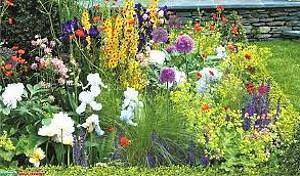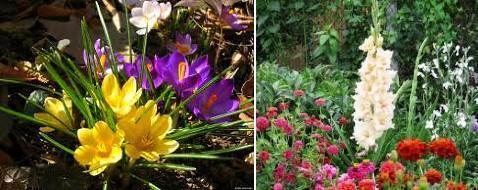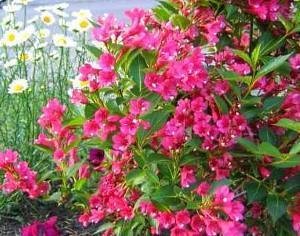How to make a flower bed of continuous flowering (features of planting and growing)
 A bed of perennials of continuous flowering is suitable for a park, patio, area in front of the house. On the Internet and periodicals, you can find many photos of continuous flowering flower beds (for plots of land of different sizes, different lighting, varied in color and species composition).
A bed of perennials of continuous flowering is suitable for a park, patio, area in front of the house. On the Internet and periodicals, you can find many photos of continuous flowering flower beds (for plots of land of different sizes, different lighting, varied in color and species composition).
Selection of plants for a flower bed of continuous flowering
In order to make a flower bed of continuous flowering in the country, you need to know the flowering period of plants and use their various life forms:
- Early spring ephemeroids are bulbous, or corms, with a short growing season. Some of them begin to bloom when there is snow; after flowering, the aboveground part quickly dies off (crocuses, snowdrops, bluewoods, hyacinths, goose onions, anemone, hellebore);
- Late spring ephemeroids: tulips, daffodils;
- Spring and early summer rhizome, tuberous and root plants: irises, aconite, peonies;
- Summer plants flowering once (for example, throw out an arrow with inflorescences) - lilies, foxgloves, gladioli, clematis, mallow, rhodiola;
- Summer-autumn continuously flowering plants that begin flowering in summer, and sometimes continue it until late autumn. Roses, lavender, chamomile, aquilegia, dahlias, daylilies, yarrow;
- Late summer and autumn plants - chrysanthemums, fat women;
- Autumn ephemeroids - colchicum, some species of blueberry and crocuses;
- Decorative flowering cereals that bloom in summer, but whose inflorescences adorn the flower bed until frost, and sometimes until spring.
Notes: For many plants, you can increase the flowering time by picking or cutting wilted flowers. This will stimulate the plant to eject new shoots from the dormant (spare) buds. For example: aquilegia, dahlias, roses, yarrow.

Woody plants for flower beds
 Ornamental flowering shrubs and shrubs have long become components of flower beds. Their sizes vary greatly: the smallest ones reach a height of only 10-15 cm, and the creeping forms can be even lower. Tall shrubs are suitable for the background of a flower garden. In addition to decorativeness, they will serve as protection from the wind and will be able to shade from too bright sun.
Ornamental flowering shrubs and shrubs have long become components of flower beds. Their sizes vary greatly: the smallest ones reach a height of only 10-15 cm, and the creeping forms can be even lower. Tall shrubs are suitable for the background of a flower garden. In addition to decorativeness, they will serve as protection from the wind and will be able to shade from too bright sun.
Some of them bloom in early spring - forsythia, some rhododendrons, wolfberry. Other shrubs bloom in late spring or summer - spirea, tree peony, bushy (star-shaped) magnolia, rhododendron, colquitia.  Hydrangea retains inflorescences for more than a month, and during flowering, the petals change color. And weigela is interesting in that it blooms twice a season - in spring and summer.
Hydrangea retains inflorescences for more than a month, and during flowering, the petals change color. And weigela is interesting in that it blooms twice a season - in spring and summer.
Among shrubs, plants with tree shoots up to 20 cm high, for a flower bed of continuous flowering are suitable:
- Cinquefoil (with proper care, it blooms until autumn);
- Dwarf rhododendrons (spring flowering);
- Common heather (blooms from late summer until frost);
- Dwarf roses (summer flowering);
- Thyme or thyme (different species differ in terms of flowering spring-summer).
Such plants can be used as curbs, creating a natural edging of the flower garden.
Dates of planting plants for flower beds
Making a flower bed of continuous flowering in the country must begin with determining the type of soil.Most decorative flowering plants of the temperate climatic zone prefer neutral or slightly acidic substrates (pH 6.0 - 7.0). But some representatives of the plant kingdom need more acidic soil, otherwise they begin to wither and die over time. The most famous of them are representatives of the heather family - erica, rhododendron, heather, blueberries, cranberries, strawberries.
If, for the scheme of a flower bed of continuous flowering, a rock garden, or rockarium, is taken, then the plants inherent in mountain biocenoses often need a calcined substrate. Alkaline pH (above 7) is preferred by: forest anemone, meadowsweet, bellflower, chalk resin, some saxifrage.
But nowadays, the term "rock garden" often means any flower bed of continuous flowering, in the design of which stones are added. Therefore, you can create a rock garden on soils with any acidity.
The planting scheme for a continuous flowering flower bed is quite simple, here are the basic rules:
- All ephemeroids blooming in spring are planted in autumn. At the same time, flowers can be placed singly, or in groups, they will not interfere with anyone, since other plants are just beginning to grow. Later, the aboveground part of the plants will die off, and will not spoil the appearance of the flower garden;
- Plant rhizomatous plants in autumn or early spring (before the beginning of the growing season), a prerequisite is to leave a place for the plant to grow;
- Perennials that are sown with seeds are more rational to sow in autumn;
- If the plants in the flowerbed vary greatly in height, then use a tiered planting: low-growing flowers are planted in the foreground, then medium-sized flowers and tall ones complete the composition;
- After planting, mulch the soil around the plants (to avoid loss of moisture from the substrate). For mulch, you can use finely chopped bark of deciduous trees, chopped straw or hay.
Note: when creating a continuous flowering flower bed of perennials, it must be borne in mind that plants that grow strongly interfere with each other. This leads to a decrease in buds, and also to the development of fungal diseases (due to poor ventilation).
Top dressing and fertilizers
All decorative flowering plants need additional feeding. In the spring, the flower garden is fertilized for good development of leaves and buds. As a mineral supplement, you can use complex fertilizers that are applied to the soil. Organic fertilizers are fed several times throughout the summer. For organic feeding, a solution of manure or droppings is suitable.